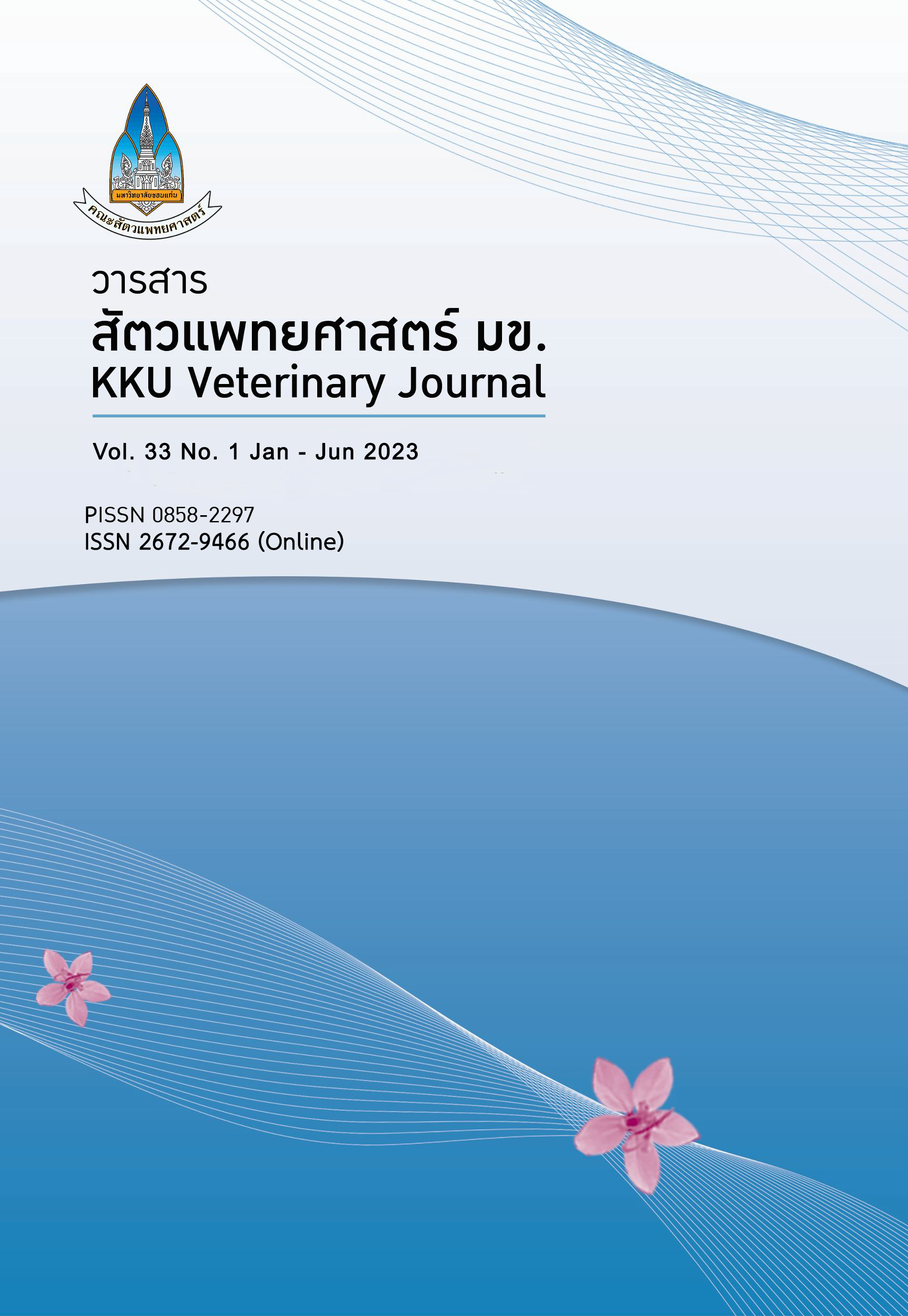A comparative study of routine rapid test and polymerase chain reaction (PCR) assays to diagnose canine tick-borne disease and associated clinical signs and hematological findings in Chonburi Province, Thailand
Main Article Content
Abstract
Objectives: To compare commercial test and polymerase chain reaction (PCR) techniques for canine tick-borne disease diagnosis and to evaluate the correlation of clinical signs and hematological profile with the disease.
Materials and Methods: Forty-five blood samples that had positive results with commercial test kits (SNAP 4DX Plus) for canine tick-borne pathogens were stored. Those samples were tested for molecular detection of Babesia canis, Hepatozoon canis, Anaplasma platys, and Ehrlichia canis by PCR technique. In addition, the prevalence of infection, related clinical signs, and hematological profile were analyzed using the Chi-square test.
Results: In this study, Anaplasma platys are the most hemoparasites found. Mixed infection of tick-borne pathogens was found in more than a single infection. Lymphopenia was associated with mixed infections; A. platys + B. canis, A. platys + H. canis, B. canis + H. canis, A. platys + B. canis + H. canis (p<0.05). In addition, B. canis was associated with pale mucous membranes (p<0.05). Overall, the result shows that the number of positive samples with rapid test kits did not match those with PCR tests (75.56%).
Conclusion: Regarding this study's results, rapid test kits could not detect mixed and B. canis infections. Mixed infections were associated with the critical hematological profile (Lymphopenia). B. canis infections were associated with the apparent clinical sign (Pale mucous membranes). We concluded that veterinarians should diagnose hemoparasitic disease in dogs based on clinical signs and hematological profiles. Detection of hemoparasite could be done by PCR for increasing diagnostic accuracy.
Article Details

This work is licensed under a Creative Commons Attribution-NonCommercial-NoDerivatives 4.0 International License.
References
Ahantarig A, Trinachartvanit W, Milne JR, 2008. Tick-borne pathogens and diseases of animals and humans in Thailand. Southeast Asian J Trop Med Public Health 39, 1015-1032.
Ayoob AL, Hackner SG, Prittie J, 2010. Clinical management of canine babesiosis. J Vet Emerg Criti Care 20, 77-89.
Laummaunwai P, Sriraj P, Aukkanimart R, Boonmars T, Boonjaraspinyo S, Sangmaneedet S, Potchimplee P, Khianman P, Maleewong W, 2014. Molecular detection and treatment of tick-borne pathogens in domestic dogs in Khon Kaen, northeastern Thailand. Southeast Asian J Trop Med Public Health 45, 1157-1166.
Rucksaken R, Maneeruttanarungroj C, Maswanna T, Sussadee M, Kanbutra P, 2019. Comparison of conventional polymerase chain reaction and routine blood smear for the detection of Babesia canis, Hepatozoon canis, Ehrlichia canis, and Anaplasma platys in Buriram Province, Thailand. Vet World 12, 700-705.
Sainz Á, Roura X, Miró G, Estrada-Peña A, Kohn B, Harrus S, Solano-Gallego L, 2015. Guideline for veterinary practitioners on canine ehrlichiosis and anaplasmosis in Europe. Parasit Vectors 8, 75.
Salakij C, Salakij J, Rochanapat N, Suthunmapinunta P, Nunklang G, 1999. Hematological characteristics of blood parasite infected dogs. Witthayasan Kasetsart 33, 589-600.
Sathish G, Subramanian S, Parthiban M, Vairamuthu S, 2021. Detection of canine blood parasites by a multiplex PCR. Vet Parasitol 35.
Singh K, Singh H, Singh NK, Kashyap N, Sood NK, Rath SS, 2017. Molecular prevalence, risk factors assessment and haemato-biochemical alterations in hepatozoonosis in dogs from Punjab, India. Comp Immunol Microbiol Infect Dis 55, 53-58.
Taweethavonsawat P, 2012. Update Ehrlichiosis in dog. The journal of Thai veterinary practitioners 24, 49-53.
Thongsahuan S, Chethanond U, Wasiksiri S, Saechan V, Thongtako W, Musikacharoen T, 2020. Hematological profile of blood parasitic infected dogs in Southern Thailand. Vet World 13, 2388-2394.
Tsachev I, Ivanov A, Dinev I, Kanakov D, 2008. Clinical Ehrlichia canis and Hepatozoon canis co-infection in a dog in Bulgaria. Rev Med Vet 159, 68-73.
Wankaew S, Asawapattanakul T, 2022. Prevalence and factors affecting of blood parasite in dogs in the veterinary teaching hospital of Mahasarakham University. Prawarun agricultural journal 19, 66-72.
Wongsawang W, Jeimthaweeboon S, 2020. Retrospective study of canine blood parasites infections in Kanchanaburi province during 2012-2016. J Anim Health Sci Tech 3, 32-42.


